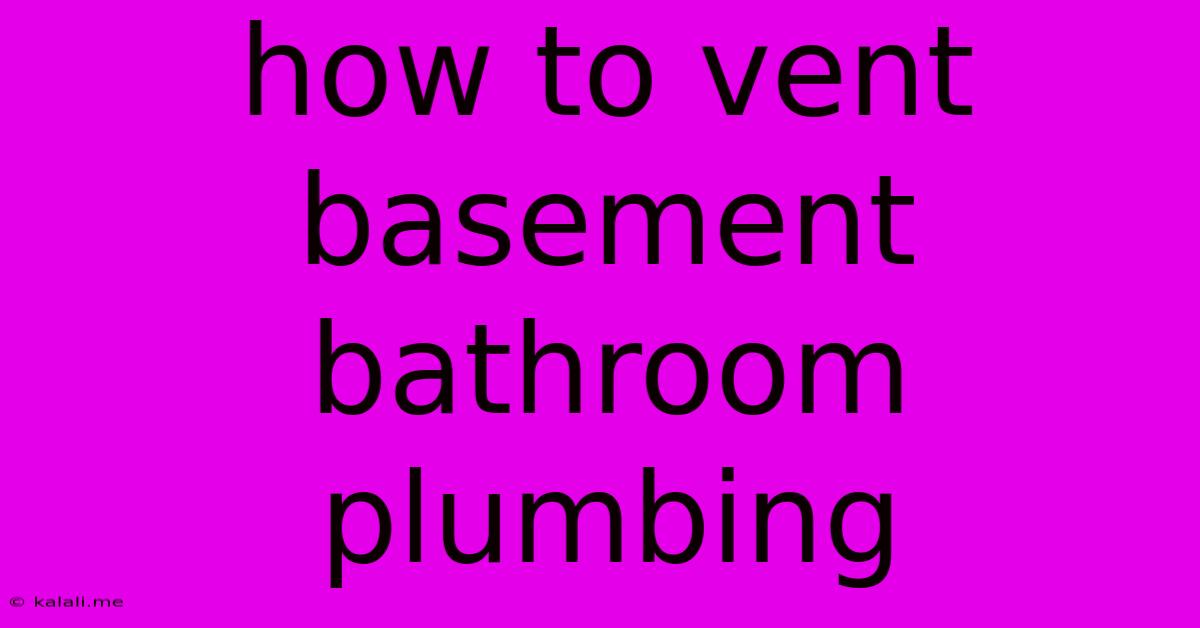How To Vent Basement Bathroom Plumbing
Kalali
Jun 08, 2025 · 4 min read

Table of Contents
How to Vent Basement Bathroom Plumbing: A Comprehensive Guide
Meta Description: Basement bathroom plumbing venting is crucial for proper drainage and preventing sewer gases from entering your home. This guide provides a step-by-step walkthrough of venting techniques, including common issues and solutions. Learn how to ensure your basement bathroom functions efficiently and safely.
A basement bathroom adds significant value to your home, providing extra convenience and space. However, proper plumbing venting is crucial for its effective and safe operation. Without adequate venting, your bathroom fixtures – toilets, sinks, and showers – can experience slow drainage, gurgling sounds, and even back up. Worse, sewer gases can infiltrate your home, creating unpleasant odors and health hazards. This comprehensive guide will walk you through the process of venting your basement bathroom plumbing, addressing common challenges and providing solutions.
Understanding the Importance of Venting
Plumbing vents allow sewer gases to escape to the outside, preventing pressure imbalances within the drainage system. These gases, which contain harmful bacteria and unpleasant odors, can build up if the system is not properly vented. A properly vented system ensures efficient drainage, preventing clogs and backups. It also maintains a stable air pressure, preventing siphoning which could leave your fixtures unusable. Key components of a proper venting system include:
- Vent Stack: The main vertical pipe that carries air from the drainage system to the roof.
- Vent Branches: Smaller pipes connecting individual fixtures to the vent stack.
- Air Admittance Valves (AAVs): Devices that allow air to enter the drainage system, often used as an alternative or supplement to traditional venting methods in specific situations.
Common Venting Challenges in Basement Bathrooms
Basement bathrooms often present unique venting challenges due to their location below ground level. These include:
- Limited Access: Running vent pipes through existing structures can be difficult and may require cutting through walls or floors.
- Existing Plumbing: Integrating new vent pipes into an existing system might require significant modifications.
- Code Compliance: Local building codes dictate minimum vent pipe sizes and locations, which need to be adhered to strictly.
Methods for Venting Basement Bathroom Plumbing
There are several methods to vent your basement bathroom plumbing, each with its own advantages and disadvantages:
1. Extending the Existing Vent Stack: This is the most common and usually preferred method. It involves extending the existing vent stack from the upper floors to accommodate the basement fixtures. This provides the most efficient venting, but it can be complex and expensive if extensive modifications are required.
2. Adding a Separate Vent Stack: If extending the existing stack is impractical, a new, separate vent stack can be installed for the basement bathroom. This requires drilling through the roof and running a new pipe, potentially requiring professional assistance.
3. Utilizing Air Admittance Valves (AAVs): AAVs are a more cost-effective and less intrusive option, particularly for individual fixtures. They allow air into the drainage system when necessary, preventing pressure buildup. However, they are not always suitable for all situations and may not provide the same level of venting as a traditional vent stack. Check local codes to ensure AAVs are permitted for your situation.
4. Using a "Wet Vent" System (Consult a Professional): In specific cases, a wet vent system might be considered, where one drain line acts as a vent for another. However, this method is usually more complex and requires careful planning to meet code requirements. This should only be done by a licensed plumber familiar with wet vent system design and installation.
Troubleshooting Common Issues
Even with proper venting, you might encounter some issues. Here are some common problems and their potential solutions:
- Slow Drainage: This could be due to a clog, inadequate venting, or a low-slope drain line. Consider using a drain snake or calling a plumber.
- Gurgling Sounds: This often indicates insufficient venting or a partial clog. Check for clogs and ensure adequate venting.
- Sewer Gas Odors: This is a clear sign of improper venting or a leak in the drainage system. Locate the source of the odor and address the venting issue or the leak immediately.
When to Call a Professional
While some simpler venting tasks might be manageable for DIY enthusiasts, complex situations such as extensive modifications to existing plumbing or the installation of a new vent stack often require the expertise of a licensed plumber. Consult a professional if you are unsure about any aspect of venting your basement bathroom. They can ensure the work is done correctly, safely, and to code, preventing future problems. Properly vented plumbing is essential for the long-term health and functionality of your basement bathroom.
Latest Posts
Latest Posts
-
How To Clean Glass Range Top
Jun 08, 2025
-
How To Get Glue Off Carpet
Jun 08, 2025
-
How To Remove A Deadbolt Lock Kwikset
Jun 08, 2025
-
Mac Os Easiest Duplicate A Cd
Jun 08, 2025
-
Water Dripping From Roof Outside No Rain
Jun 08, 2025
Related Post
Thank you for visiting our website which covers about How To Vent Basement Bathroom Plumbing . We hope the information provided has been useful to you. Feel free to contact us if you have any questions or need further assistance. See you next time and don't miss to bookmark.